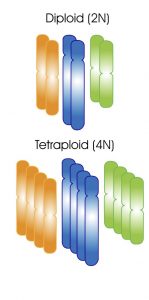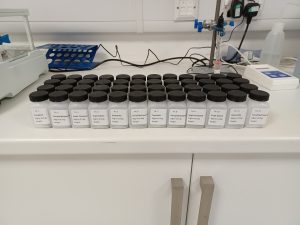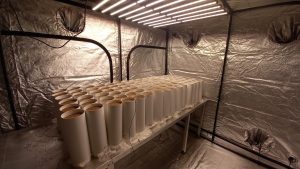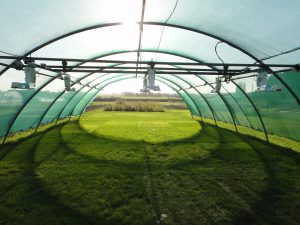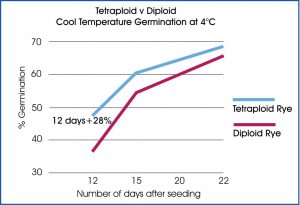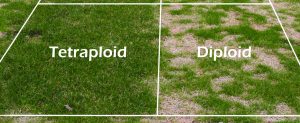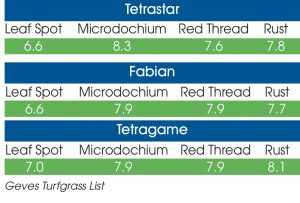A grass for all seasons
Related Articles
Amenity tetraploid perennial ryegrass cultivars are proving to be highly beneficial for golf courses dealing with threats of disease and pests in both extreme heat and cold conditions, and a lack of light. Jayne Leyland explains why.
A new generation of amenity tetraploid perennial ryegrass cultivars offer exceptional qualities for golf courses. Fast establishment, recovery, cold temperature growth, superior stress tolerance and high root mass makes them suitable for a wide range of applications around the course including tees and the general area. But what makes them so exceptional?
Ploidy
Ploidy refers to the number of complete sets of chromosomes within the nucleus of each plant cell. Perennial ryegrasses bred for amenity use were historically diploids, meaning two paired sets of chromosomes within each plant cell. Tetra (Greek translation for four), relates to tetraploids having four paired sets of chromosomes within each cell, doubling the number per cell. Chromosomes, derived from the Greek chroma (colour) and soma (body) are thread-like structures arranged in pairs, each made of protein and a single molecule of hereditary DNA (deoxyribonucleic acid).
Polyploidy is naturally occurring in many wild and cultivated plant species, including wheat, potatoes and fine fescues. It can also be induced in plants through the application of a natural alkaloid plant hormone colchicine, derived from the plant Colchicum autumnale (Autumn Crocus). Colchicine acts as a mitosis inhibitor, resulting in the chromosome doubling within each cell, thus diploid (2n) becomes tetraploid (4n). The doubling of chromosomes benefits tetraploids to deliver enhanced performance.
Energised
Each tetraploid cell contains double the chloroplast of a diploid. Chloroplast comes from the Greek translation chloros (green) and phyllon (leaf). Thylakoids inside the chloroplast contain the light harvesting complex, including the chlorophyll green pigments essential to photosynthesis, absorbing sunlight in energy rich molecules. Photosynthesis converts the light energy into chemical energy, which is stored as carbohydrates and synthesized with water and carbon dioxide to produce energy for the plant. In a nutshell, the increased cellular chloroplast benefits the plant by boosting chlorophyll production for energy absorption and processing. The outcome is a high energy, robust, hard-wearing, healthier plant with improved stress tolerance and recovery capability, even in cooler temperatures.
Development
A tetraploid cultivar begins its journey as seed selected from an amenity diploid cultivar with desirable characteristics. A few grammes of this seed is treated with the hormone; the resultant plants produce larger, high energy seeds, around 500-600 seeds per gramme compared with 700-800 seeds for ultra-fine ryes.
Several plants from the same parent are grown in isolation under glass for observation with leaves and shoots having chromosome counts in the laboratory using flow cytometry, a laser based biophysical technology for cell counting. It may take several generations of tetraploid offspring to yield stable, viable breeders seed for use in field testing. Potential new cultivars are pushed to the limit and vital characteristics such as growth habit, wear, disease and drought tolerance, mowing height and visual merit are assessed. Only one or two cultivars make it through this rigorous process from the many thousands of early selections. The successful candidates must conform to DUS protocols, that being distinct, uniform and stable, which is the pre-condition for granting breeders rights to enable commercial production, certification and sale of seed.
Research into the benefits of tetraploids continues at Origin Amenity Solutions Research Centre, Essex. Automated watering, full spectrum LED lights simulating daylight conditions in May / June and regulated soil temperatures monitored with Soil Scout sensors ensure conditions are within range. Watch this space for future outcomes!
In the dark
Double chloroplast means tetraploids can harness relatively more available light, very useful when there is poor light quality, overcast conditions, shorter day length and shade (where temperatures are relatively cooler). Origin Amenity Solutions breeding partner Top Green routinely assesses all new tetraploid cultivars in the shade and wear tolerance trial under reduced light levels of 60 percent PAR (photosynthetic active radiation).
Cool performers
Tetraploids germinate and establish faster than diploid ryes, even in cold soil temperatures from just 4°C! Such high energy seed, superior winter wear and robust re-growth helps maintain grass cover on tees, bottle-necks and walkways throughout the challenging winter season with regular divotting. The ultimate cold mix is R314 Rye, a blend of amenity tetraploid and annual ryegrasses for use during the winter season for ‘get it green’ repairs.
Fast establishment is vital, not only in winter but all year round, particularly as UK golf rounds were up 46 percent for the third quarter of 2021 (July, August and September) compared with the same quarter of 2019.
Under such intense wear pressure, the speed of emergence and high root mass helps restore a surface in the shortest possible time, making 4Tetra (100 percent tetraploid rye blend), R140 (50/50 tetraploid / diploid blend) and R25CRT (tetraploid / creeping / diploid) perfect for divotting, repairs or renovation any time of year.
Hot stuff
High root mass and deep rooting means tetraploids are vital to heat survival, giving greater drought tolerance and stability. They are the first and fastest to recover from a prolonged period of heat and drought stress, an ideal choice for free-draining soils and sites exposed to full sun or without irrigation. For example, R6CRT includes tetraploid rye, hard fescue and creeping red fescue for a dense, hard-wearing sward with tolerance to and recovery from heat and drought.
Toughen up
High disease pressure can devastate the performance and visual qualities of the sward. Selecting cultivars with high disease tolerance is an important part of an integrated management approach. The official GEVES European Turf Testing Programme demonstrates the great tolerance tetraploids have to common turf diseases such as Microdochium Patch, Red Thread and Rust.
Go-to choice
A relatively recent introduction to the amenity market, the use of tetraploids has rocketed thanks to their proven performance and flexibility for wide-ranging applications right throughout the year. Blended with diploid ryegrasses or mixed with fescues they are reliable performers that always deliver.
For more information on the choice of R Range tetraploid technology mixes for your course, contact Origin Amenity Solutions www.originamenity.com
Jayne Leyland is the seeds product manager for Origin Amenity Solutions

